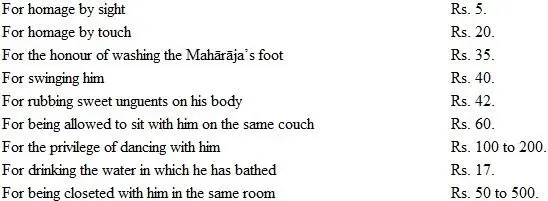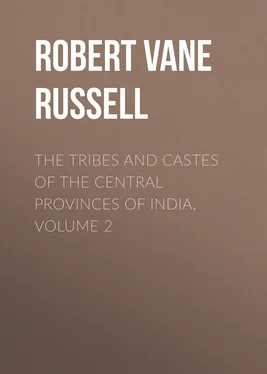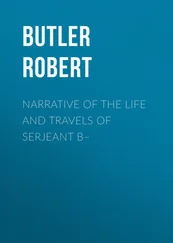Robert Vane Russell - The Tribes and Castes of the Central Provinces of India, Volume 2
Здесь есть возможность читать онлайн «Robert Vane Russell - The Tribes and Castes of the Central Provinces of India, Volume 2» — ознакомительный отрывок электронной книги совершенно бесплатно, а после прочтения отрывка купить полную версию. В некоторых случаях можно слушать аудио, скачать через торрент в формате fb2 и присутствует краткое содержание. Жанр: foreign_prose, История, foreign_edu, foreign_antique, на английском языке. Описание произведения, (предисловие) а так же отзывы посетителей доступны на портале библиотеки ЛибКат.
- Название:The Tribes and Castes of the Central Provinces of India, Volume 2
- Автор:
- Жанр:
- Год:неизвестен
- ISBN:нет данных
- Рейтинг книги:4 / 5. Голосов: 1
-
Избранное:Добавить в избранное
- Отзывы:
-
Ваша оценка:
- 80
- 1
- 2
- 3
- 4
- 5
The Tribes and Castes of the Central Provinces of India, Volume 2: краткое содержание, описание и аннотация
Предлагаем к чтению аннотацию, описание, краткое содержание или предисловие (зависит от того, что написал сам автор книги «The Tribes and Castes of the Central Provinces of India, Volume 2»). Если вы не нашли необходимую информацию о книге — напишите в комментариях, мы постараемся отыскать её.
The Tribes and Castes of the Central Provinces of India, Volume 2 — читать онлайн ознакомительный отрывок
Ниже представлен текст книги, разбитый по страницам. Система сохранения места последней прочитанной страницы, позволяет с удобством читать онлайн бесплатно книгу «The Tribes and Castes of the Central Provinces of India, Volume 2», без необходимости каждый раз заново искать на чём Вы остановились. Поставьте закладку, и сможете в любой момент перейти на страницу, на которой закончили чтение.
Интервал:
Закладка:
Their headquarters are at Muttra, and their chief festival is the Janam-Ashtami 103 103 Lit. the birth on the eighth day, as Krishna was born on the 8th of dark Bhādon.
or Krishna’s birthday. Their sect-mark consists of two white lines down the forehead with a black patch in the centre, which is called Shiāmbindini. Shiām means black, and is a name of Krishna. They also sometimes have a circular line across the nose, which represents the moon.
6. The Mādhavachāryas.
The third great order is that of the Mādhavas, named after a saint called Mādhavachārya in southern India. He attempted to reconcile the warring Sivites and Vishnuites by combining the worship of Krishna with that of Siva and Pārvati. The doctrine of the sect is that the human soul is different from the divine soul, and its members are therefore called dualists. They admit a distinction between the divine soul and the universe, and between the human soul and the material world. They deny also the possibility of Nirvāna or the absorption and extinction of the human soul in the divine essence. They destroy their thread at initiation, and also wear red clothes like the Sivite devotees, and like them also they carry a staff and water-pot. The tilak of the Mādhavachāryas is said to consist of two white lines down the forehead and continued on to the nose where they meet, with a black vertical line between them.
7. The Vallabhachāryas.
The fourth main order is the Vishnu-Swāmi, which is much better known as the Vallabhachārya sect, called after its founder Vallabha, who was born in A.D. 1479. The god Krishna appeared to him and ordered him to marry and set up a shrine to the god at Gokul near Mathura (Muttra). The sect worship Krishna in his character of Bāla Gopāla or the cowherd boy. Their temples are numerous all over India, and especially at Mathura and Brindāban, where Krishna was brought up as a cowherd. The temples at Benāres, Jagannāth and Dwārka are rich and important, but the most celebrated shrine is at Sri Nāthadwāra in Mewār. The image is said to have transported itself thither from Mathura, when Aurāngzeb ordered its temple at Mathura to be destroyed. Krishna is here represented as a little boy in the act of supporting the mountain Govardhan on his finger to shelter the people from the storms of rain sent by Indra. The image is splendidly dressed and richly decorated with ornaments to the value of several thousand pounds. The images of Krishna in the temples are commonly known as Thākurji, and are either of stone or brass. At all Vallabhachārya temples there are eight daily services: the Mangala or morning levée , a little after sunrise, when the god is taken from his couch and bathed; the Sringāra, when he is attired in his jewels and seated on his throne; the Gwāla, when he is supposed to be starting to graze his cattle in the woods of Braj; the Rāj Bhog or midday meal, which, after presentation, is consumed by the priests and votaries who have assisted at the ceremonies; the Uttāpan, about three o’clock, when the god awakes from his siesta; the Bhog or evening collation; the Sandhiya or disrobing at sunset; and the Sayan or retiring to rest. The ritual is performed by the priests and the lay worshipper is only a spectator, who shows his reverence by the same forms as he would to a human superior. 104 104 Mr. Crooke’s Tribes and Castes , art. Vallabhachārya.
Anchorite sitting on iron nails.
The priests of the sect are called Gokalastha Gosain or Mahārāja. They are considered to be incarnations of the god, and divine honours are paid to them. They always marry, and avow that union with the god is best obtained by indulgence in all bodily enjoyments. This doctrine has led to great licentiousness in some groups of the sect, especially on the part of the priests or Mahārājas. Women were taught to believe that the service of and contact with the priest were the most real form of worshipping the god, and that intercourse with him was equivalent to being united with the god. Dr. Bhattachārya quotes 105 105 Hindu Castes and Sects , p. 457.
the following tariff for the privilege of obtaining different degrees of contact with the body of the Mahārāja or priest:

The public disapprobation caused by these practices and their bad effect on the morality of women culminated in the great Mahārāj libel suit in the Bombay High Court in 1862. Since then the objectionable features of the cult have to a large extent disappeared, while it has produced some priests of exceptional liberality and enlightenment. The tilak of the Vallabhachāryas is said to consist of two white lines down the forehead, forming a half-circle at its base and a white dot between them. They will not admit the lower castes into the order, but only those from whom a Brāhman can take water.
8. Minor sects.
Besides the main sects as described above, Vaishnavism has produced many minor sects, consisting of the followers of some saint of special fame, and mendicants belonging to these are included in the body of Bairāgis. One or two legends concerning such saints may be given. A common order is that of the Bendiwāle, or those who wear a dot. Their founder began putting a red dot on his forehead between the two white lines in place of the long red line of the Rāmānandis. His associates asked him why he had dared to alter his tilak or sect-mark. He said that the goddess Jānki had given him the dot, and as a test he went and bathed in the Sarju river, and rubbed his forehead with water, and all the sect-mark was rubbed out except the dot. So the others recognised the special intervention of the goddess, and he founded a sect. Another sect is called the Chaturbhuji or four-armed, Chaturbhuj being an epithet of Vishnu. He was taking part in a feast when his loin-cloth came undone behind, and the others said to him that as this had happened, he had become impure at the feast. He replied, ‘Let him to whom the dhoti belongs tie it up,’ and immediately four arms sprang from his body, and while two continued to take food, the other two tied up his loin-cloth behind. Thus it was recognised that the Chaturbhuji Vishnu had appeared in him, and he was venerated.
9. The seven Akhāras.
Among the Bairāgis, besides the four Sampradāyas or main orders, there are seven Akhāras. These are military divisions or schools for training, and were instituted when the Bairāgis had to fight with the Gosains. Any member of one of the four Sampradāyas can belong to any one of the seven Akhāras, and a man can change his Akhāra as often as he likes, but not his Sampradāya. The Akhāras, with the exception of the Lasgaris, who change the red centre line of the Rāmanāndis into a white line, have no special sect-marks. They are distinguished by their flags or standards, which are elaborately decorated with gold thread embroidered on silk or sometimes with jewels, and cost two or three hundred rupees to prepare. These standards were carried by the Nāga or naked members of the Akhāra, who went in front and fought. Once in twelve years a great meeting of all the seven Akhāras is held at Allahābād, Nāsik, Ujjain or Hardwār, where they bathe and wash the image of the god in the water of the holy rivers. The quarrels between the Bairāgis and Gosains usually occurred at the sacred rivers, and the point of contention was which sect should bathe first. The following is a list of the seven Akhāras: Digambari, Khāki, Munjia, Kathia, Nirmohi, Nirbāni or Niranjani and Lasgari.
Читать дальшеИнтервал:
Закладка:
Похожие книги на «The Tribes and Castes of the Central Provinces of India, Volume 2»
Представляем Вашему вниманию похожие книги на «The Tribes and Castes of the Central Provinces of India, Volume 2» списком для выбора. Мы отобрали схожую по названию и смыслу литературу в надежде предоставить читателям больше вариантов отыскать новые, интересные, ещё непрочитанные произведения.
Обсуждение, отзывы о книге «The Tribes and Castes of the Central Provinces of India, Volume 2» и просто собственные мнения читателей. Оставьте ваши комментарии, напишите, что Вы думаете о произведении, его смысле или главных героях. Укажите что конкретно понравилось, а что нет, и почему Вы так считаете.












